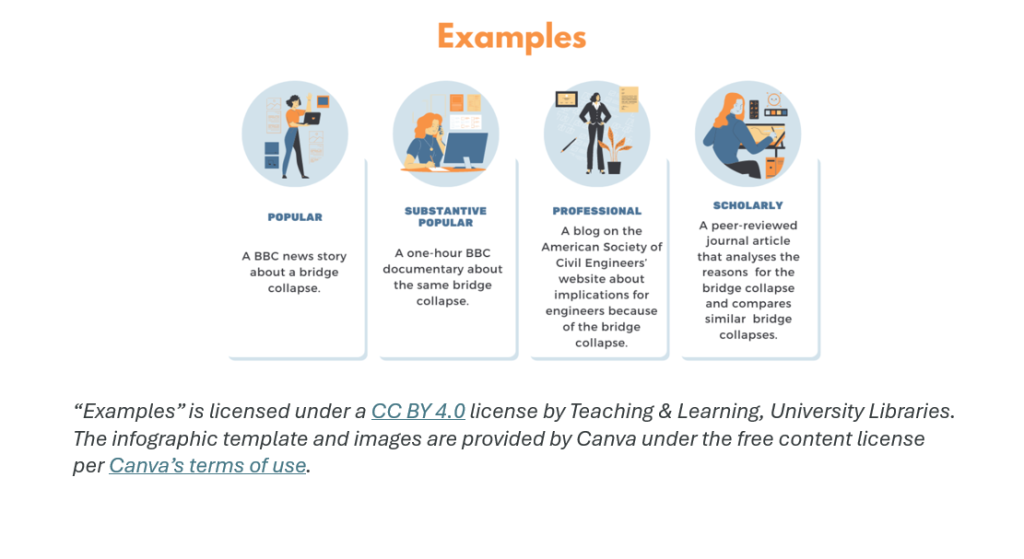Types of Information Sources
Scholarly Versus Popular Sources
One way to categorize information is by the expertise of its intended audience. Considering the intended audience—how expert one has to be to understand the information—can indicate whether the source has sufficient credibility and thoroughness to meet your need. There are varying degrees of expertise: Scholarly, Popular and Professional. Scholarly sources make up the core of a university library’s collections, as these are what third-level students and researchers engage with the most.
Scholarly sources
Journal articles (such as those published in the journals Plant Science and Education and Child Psychology) are meant for scholars, students, and the general public who want a deep understanding of a problem or issue. Researchers and scholars write these articles to present new knowledge and further understanding of their field of study. Additionally, they are:
- Where findings of research projects, data and analytics, and case studies usually appear first.
- Often long (usually over 10 pages) and always include footnotes and references.
- Usually published by universities, professional associations, and commercial publishers.
- Published after approval by peer review or from the journal’s editor
Scholarly information can also come in the form of books, particularly in the humanities and some social sciences. These can be in monograph form (an extended analysis of a single topic by a single or several authors) or in an edited volume (where many authors contribute different takes on a theme, each writing up a contributory chapter).
The value of scholarly journals
Articles in scholarly journals are valued for several reasons. First, they are usually trustworthy because their publication process includes a peer review that helps insure their accuracy and contribution to their disciplines. In addition, they often contain the first reports of new research, which makes their sections on methodology, data, analysis, and interpretation primary sources. Sometimes they instead consist of literature reviews summaries of multiple research studies done in the past on particular subjects of current interest. That makes those articles very helpful secondary sources.
Peer-reviewed sources
The most-respected scholarly journals are peer-reviewed, which means that experts in their field other than the author and editor check out each article before it can be published. It’s their responsibility to help guarantee that new material is presented in the context of what is already known, that the methods the researcher used are the right ones, and that the article contributes to the field. For those reasons, peer-reviewed articles are more likely to be credible. Peer-reviewed journal articles are the official scholarly record, which means that if it’s an important development in research, it will probably turn up in a journal article eventually.
Popular Sources
Newspaper and magazine articles (such as those found in The Irish Times, the New Yorker, and Hot Press) are meant for a large general audience, are generally affordable, and are easy to purchase or available for free. They are written by staff writers or reporters for the general public. Additionally, they are:
- About news, opinions, background information, and entertainment.
- More attractive than scholarly journals, with catchy titles, attractive artwork, and many advertisements but no footnotes or references.
- Often published by commercial publishers, often after approval from an editor.
Professional Sources
Professional magazine articles (such as those found in the magazines Plastic Surgical Nursing and Music Teacher) are meant for people in a particular profession, and are often accessible through a professional organization. Staff writers or other professionals in the targeted field write these articles at a level and with the language to be understood by everyone in the profession.
Additionally, they are:
- About trends and news from the targeted field, book reviews, and case studies.
- Often less than 10 pages, some of which may contain footnotes and references.
- Usually published by professional associations and commercial publishers.
- Published after approval from an editor.

